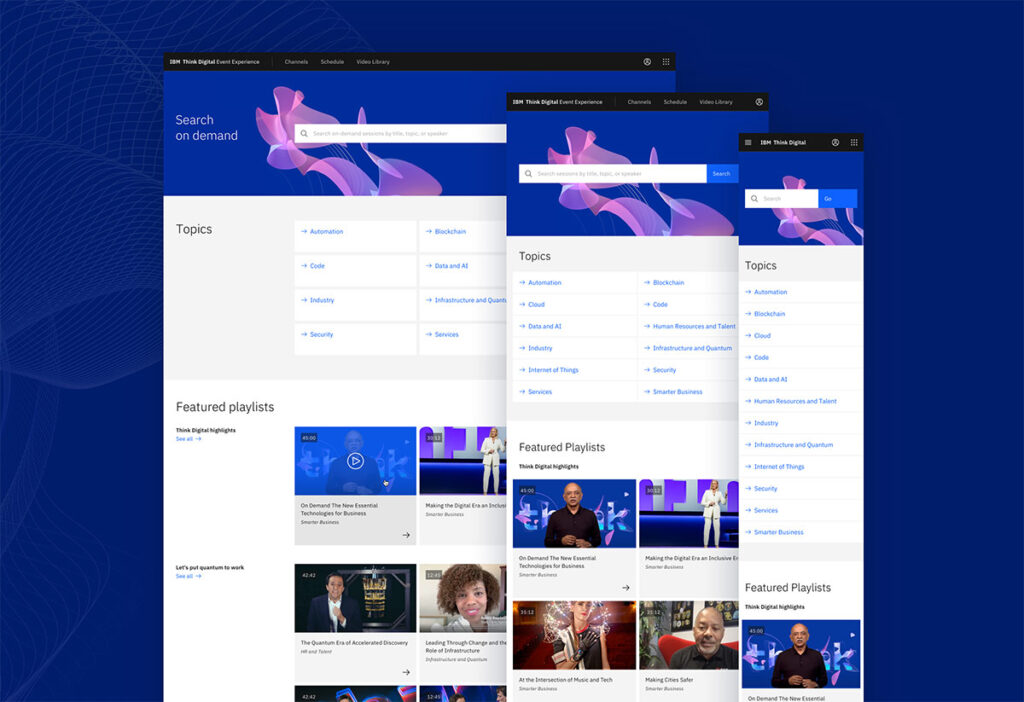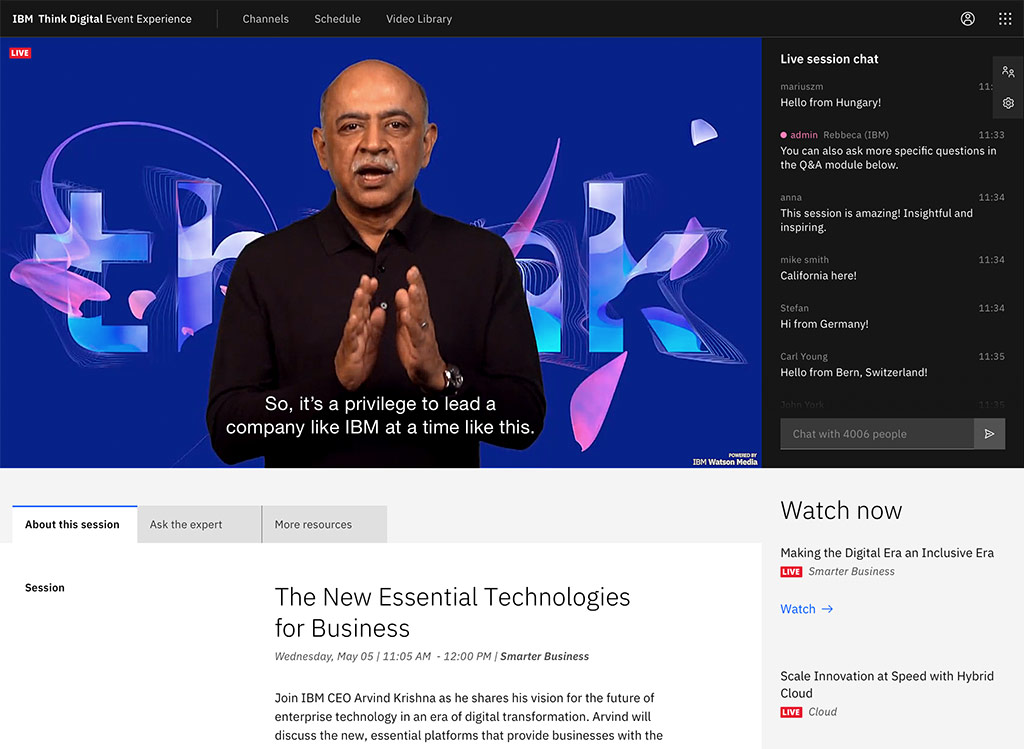
Due to the rapid pace of COVID-19, there has been a need to act with agility, resilience and unity in the face of evolving impacts. On March 19, 2020, with just 47 days before the in-person conference was scheduled to start, the decision was finalized to pivot to an all-digital experience for IBM Think as a result of COVID-19. This would be the first time the event would be online-only.
IBM Think Digital experience resulted in nearly 120,000 registrants and over 170,000 unique viewers. The Think content team took over 2500 sessions that were planned for the face to face event and selected the most impactful 250 sessions that could pivot the message to be COVID-19 relevant as well as engage attendees digitally. Over 45,000 hours of content were viewed by attendees with emphasis on design that would accelerate the transformation of the experience from in-person to all digital. Content was captioned in 7 different languages and delivered with live chats and moderated “Ask the expert” sessions for an audience size that was vastly beyond projected expectations.
Discover how IBM met this challenge through its own technology, leveraging both IBM Watson Media and the IBM Public Cloud to offer a scalable, reliable solution with global load balancing to help ensure a premium viewing experience for all.
Bold moves lead the way in digital events development
COVID-19 led to a worldwide emergency in which physical events and small in-person gatherings were not simply problematic but deemed unsafe and prohibited by WHO and most government authorities. Many traditional trade shows and annual conferences canceled or postponed until a digital solution could be well vetted.
IBM made the bold decision to hold the digital conference on the intended in-person date and time was of the essence. “As we made the decision to go digital, we knew that our clients and Business Partners were looking for IBM to help navigate through these unprecedented times. So, while other events were being postponed or cancelled, we knew we needed to bring a digital experience that would showcase our expertise in a relevant and actionable way,” said Vice President of IBM Event Marketing Colleen Bisconti.
The goals of this new digital experience was to offer COVID specific learning, active attendee engagement with subject matter experts and networking among peers. With these lofty goals in mind the team also agreed that beyond session and engagement the most important Think Digital elements were stability and security for all attendees.
Modern, simple, scalable
IBM Watson Media digital event solutions streamed elements from previous Think conferences, as well as other major events like the Salesforce Dreamforce conference and R+F Virtual. The Watson Media solution was tested and proved able to support over a million concurrent users on a single broadcast. This allowed the IBM Think event team to focus on the event experience without having to worry about the scale.
“Our primary goal was to meet the needs of our digital attendee on IBM technology, delivering an experience that was secure, scalable and could handle high currency and video quality. Our previous work with Watson Media gave us the research and baseline for how users consume video content, but the shift to digital gave us a new challenge to enhance the user experience and keep our attendees focused,” said Lindy Dukes, Director of Event Marketing at IBM. IBM Watson Media had a history of supporting simultaneous live streams delivered to massive audiences. It would be necessary to combine that streaming with other functionality like built-in chat, Q&A, Polling, and clickable video overlays to deliver the end user experience as designed.
It was important that IBM Think attendees be able to build their own agendas and experiences the same way they would for a physical event. To accommodate, an event microsite was built using the Watson Media APIs. In the final design, the event schedule was pulled from the event management system to allow viewers to see what was happening throughout the day to plan their schedule.

In addition to navigation, a lot of attention was also paid to both the chat and Q&A modules. The chat module was located to the right of the video player and the Q&A portion was found below the video experience. Watson Media launched a new feature for Think Digital, the ability to directly message other attendees one-on-one to try and keep a sense of networking amongst attendees available. This same digital networking feature was also leveraged by IBM digital sellers, allowing them to reach out to specific customers for a one-on-one chat during a live session. Moderation of these chat and Q&A sessions was also important for the event and enabled for comments to be removed from the chat or Q&A to keep conversations going in the right direction.
Registration transition
By the time the decision was made to pivot Think 2020 to digital, nearly 30,000 registrations were already recorded in the system that had been tracking registrations for the in-person event. Thankfully, the Watson Media digital event solution was able to connect to the existing registration system so registrations for the digital experience could be managed by the same system. Since travel was no longer required to attend, the Think Digital team expected the number of online attendees to dramatically increase. The technology running IBM Think Digital would have to scale greatly beyond the known baseline.
Security and ease of use
Once registered, conference attendees were authenticated in the event console via API, while usage was tracked and provided for analysis post event. This allowed for single sign-on (SSO) for those who already utilized an IBM ID while also not slowing down those who created an ID specifically for the event. Access time was also opened so that users only had to login once during the multi day event, promoting the access of content again and again. And, while the majority of content was available only after logging in, some thought leadership sessions were streamed publicly, giving last minute registrants something to watch while they simultaneously went through registration process.
Security testing of the solution was done by IBM X-Force Threat Intelligence.
Audience: beyond expectations
Expectations for the event continued to grow the closer things got toward go-live on May 5, 2020. Much of this was fueled by a change in dynamic from physical to virtual. For physical events, registrations tend to taper off the closer toward the date. For virtual, though, they can accelerate. “Each day brought a new learning to the team. Our registration target started at 30,000, which we now know was very modest for this type of digital event” said Colleen Bisconti “We saw the message of our Digital conference resonated with audiences across the globe. As our event message gained momentum, so did our attendee target, our final documented target was 100,000 digital attendees. We surpassed it.”
Registration momentum continued up until the day of, as support for last minute registrations was accommodated for. This peaked at around 400 simultaneous people trying to register for IBM Think toward the end, which happened right before the opening keynote. What started with modest expectations was now a breakthrough success, with about 120,000 overall registrations and over 170,000 unique viewers.

Throughout this, though, scale was not a concern. The IBM Enterprise Video Streaming technology was able to easily accommodate the surge in attendees, without having to make any last-minute changes or manually provision any additional capacity. This was achieved through a sophisticated, worldwide delivery process.
This was achieved through a sophisticated, worldwide delivery process and through worker-node autoscaling, to help ensure that the system could elastically accommodate many thousands of concurrent attendees. The experience also included automatic speech-to-text transcription for both live feeds and a video-on-demand library. Session streams were made globally available through the IBM Cloud content delivery network (CDN) along with other 3rd party CDNs.
Results
IBM Think Digital 2020 attracted over three times the number of clients and over two times the amount of business partners compared to the IBM Think 2019 event. On average, both clients and partners consumed 6.5 sessions and watched the majority of those sessions as well. Digital Development Representatives (DDRs) were actively chatting with and qualifying attendees, using the new direct message feature. One side benefit of having the all-digital event was that IBM’s largest clients were able to have larger teams of people participate. In the past, these same clients would have sent a select few to the physical event. As a result, IBM Think 2020 showed strong results for attracting new clients compared to previous, physical based versions of the conference.
Furthermore, the library of on-demand IBM Think Digital 2020 content continues to attract new registrations, greatly extending the life of the event programming.
2021 and beyond
IBM Think Digital 2020 was a tremendous success. That accomplishment will shape IBM Think events for years to come. “No one can be sure of what the future of large scale physical events will look like, however, moving forward we will create a hybrid model of digital and physical events. With that in mind, we will continue to expand and enhance our Think Digital experience to meet the needs of our clients, prospects and Business Partners ”, said Colleen Bisconti.